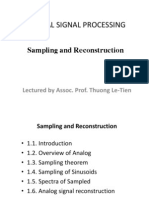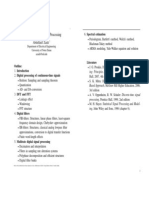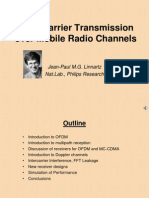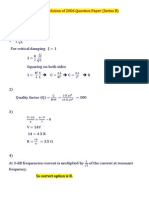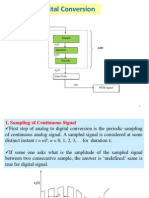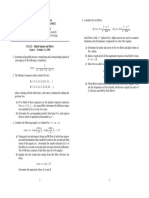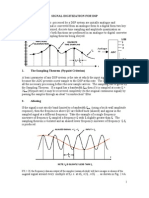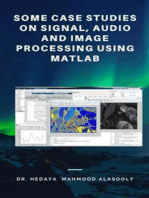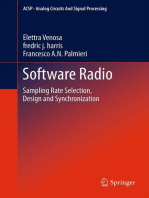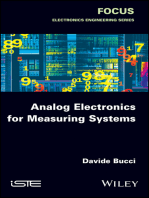1 Basics DSP AV Intro
1 Basics DSP AV Intro
Uploaded by
Ubaid UmarCopyright:
Available Formats
1 Basics DSP AV Intro
1 Basics DSP AV Intro
Uploaded by
Ubaid UmarCopyright
Available Formats
Share this document
Did you find this document useful?
Is this content inappropriate?
Copyright:
Available Formats
1 Basics DSP AV Intro
1 Basics DSP AV Intro
Uploaded by
Ubaid UmarCopyright:
Available Formats
Basics on Digital Signal Processing
Introduction
Vassilis Anastassopoulos
Electronics Laboratory, Physics Department,
University of Patras
2/36
Outline of the Course
1. Introduction (sampling quantization)
2. Signals and Systems
3. Z-Transform
4. The Discreet and the Fast Fourier Transform
5. Linear Filter Design
6. Noise
7. Median Filters
3/36
-0.2
-0.1
0
0.1
0.2
0.3
0 2 4 6 8 10
sampling time, t
k
[ms]
V
o
l
t
a
g
e
[
V
]
t
s
-0.2
-0.1
0
0.1
0.2
0.3
0 2 4 6 8 10
sampling time, t
k
[ms]
V
o
l
t
a
g
e
[
V
]
t
s
Analog & digital signals
Continuous function V
of continuous variable t
(time, space etc) : V(t).
Analog
Discrete function V
k
of
discrete sampling
variable t
k
, with k =
integer: V
k =
V(t
k
).
Digital
-0.2
-0.1
0
0.1
0.2
0.3
0 2 4 6 8 10
time [ms]
V
o
l
t
a
g
e
[
V
]
Uniform (periodic) sampling.
Sampling frequency f
S
= 1/ t
S
Sampled
Signal
4/36
Analog & digital systems
5/36
Digital vs analog processing
Digital Signal Processing (DSPing)
More flexible.
Often easier system upgrade.
Data easily stored -memory.
Better control over accuracy
requirements.
Reproducibility.
Linear phase
No drift with time and
temperature
Advantages
A/D & signal processors speed:
wide-band signals still difficult to
treat (real-time systems).
Finite word-length effect.
Limitations
6/36
DSPing: aim & tools
Software
Programming languages: Pascal, C / C++ ...
High level languages: Matlab, Mathcad, Mathematica
Dedicated tools (ex: filter design s/w packages).
Applications
Predicting a systems output.
Implementing a certain processing task.
Studying a certain signal.
General purpose processors (GPP), -controllers.
Digital Signal Processors (DSP).
Programmable logic ( PLD, FPGA ).
Hardware real-time
DSPing
Fast
Faster
7/36
Related areas
8/36
Applications
9/36
Important digital signals
Unit Impulse or Unit Sample.
The most important signal for
two reasons
(n)=1 for n=0
Unit Step u(n)=1 for n>0
(n)=u(n)-u(n-1)
Unit Ramp r(n)=nu(n)
(nT
s
)
[(n-3)
s
]
n
s
past
u(nTs)
ns past
r(nTs)
ns past
10/36
Digital system example
ms
V
A
N
A
L
O
G
D
O
M
A
I
N
ms
V
Filter
Antialiasing
k
A
D
I
G
I
T
A
L
D
O
M
A
I
N
A/D
k
A
Digital
Processing
ms
V
A
N
A
L
O
G
D
O
M
A
I
N
D/A
ms
V
Filter
Reconstruction
Sometimes steps missing
- Filter + A/D
(ex: economics);
- D/A + filter
(ex: digital output wanted).
General scheme
Topics of this
lecture.
Digital
Processing
Filter
Antialiasing
A/D
11/36
Digital system implementation
Sampling rate.
Pass / stop bands.
KEY DECISION POINTS:
Analysis bandwidth, Dynamic range
No. of bits. Parameters.
1
2
3
Digital
Processing
A/D
Antialiasing
Filter
ANALOG INPUT
DIGITAL OUTPUT
Digital format.
What to use for processing?
12/36
AD/DA Conversion General Scheme
13/36
AD Conversion - Details
14/36
Sampling
15/36
Sampling
How fast must we sample a continuous
signal to preserve its info content?
Ex: train wheels in a movie.
25 frames (=samples) per second.
Frequency misidentification due to low sampling frequency.
Train starts wheels go clockwise.
Train accelerates wheels go counter-clockwise.
1
Why?
16/36
Rotating Disk
How fast do we have to instantly
stare at the disk if it rotates
with frequency 0.5 Hz?
17/36
The sampling theorem
A signal s(t) with maximum frequency f
MAX
can be
recovered if sampled at frequency f
S
> 2 f
MAX
.
Condition on f
S
?
f
S
> 300 Hz
t) cos(100 t) sin(300 10 t) cos(50 3 s(t) + =
F
1
=25 Hz, F
2
= 150 Hz, F
3
= 50 Hz
F
1
F
2
F
3
f
MAX
Example
1
Theo
*
*
Multiple proposers: Whittaker(s), Nyquist, Shannon, Kotelnikov.
Nyquist frequency (rate) f
N
= 2 f
MAX
or f
MAX
or f
S,MIN
or f
S,MIN
/2
Naming gets
confusing !
18/36
Sampling and Spectrum
19/36
Sampling low-pass signals
-B 0 B f
Continuous spectrum
(a) Band-limited signal:
frequencies in [-B, B] (f
MAX
= B).
(a)
-B 0 B f
S
/2 f
Discrete spectrum
No aliasing
(b) Time sampling frequency
repetition.
f
S
> 2 B no aliasing.
(b)
1
0 f
S
/2 f
Discrete spectrum
Aliasing & corruption
(c)
(c) f
S
2 B aliasing !
Aliasing: signal ambiguity
in frequency domain
20/36
Antialiasing filter
-B 0 B f
Signal of interest
Out of band
noise
Out of band
noise
-B 0 B f
S
/2
f
(a),(b) Out-of-band noise can aliase
into band of interest. Filter it before!
(a)
(b)
(c)
Passband: depends on bandwidth of
interest.
Attenuation A
MIN
: depends on
ADC resolution ( number of bits N).
A
MIN, dB
~ 6.02 N + 1.76
Out-of-band noise magnitude.
Other parameters: ripple, stopband
frequency...
(c) Antialiasing filter
1
21/36
Under-sampling
1
Using spectral replications to reduce
sampling frequency f
S
reqments.
m
B
C
f 2
S
f
1 m
B
C
f 2
s s
+
+
me , selected so that f
S
> 2B
B
0 f
C
f
Bandpass signal
centered on f
C
-f
S
0 f
S
2f
S
f
f
C
Advantages
Slower ADCs / electronics
needed.
Simpler antialiasing filters.
f
C
= 20 MHz, B = 5MHz
Without under-sampling f
S
> 40 MHz.
With under-sampling f
S
= 22.5 MHz (m=1);
= 17.5 MHz (m=2); = 11.66 MHz (m=3).
Example
22/36
Quantization and Coding
q
N Quantization Levels
Quantization Noise
23/36
SNR of ideal ADC
2
( )
|
|
.
|
\
|
=
)
q
RMS(e
input RMS
10
log 20
ideal
SNR (1)
Also called SQNR
(signal-to-quantisation-noise ratio)
Ideal ADC: only quantisation error e
q
(p(e) constant, no stuck bits)
e
q
uncorrelated with signal.
ADC performance constant in time.
Assumptions
( ) ( )
2 2
FSR
V
T
0
dt
2
t sin
2
FSR
V
T
1
input RMS = |
.
|
\
|
=
}
Input(t) = V
FSR
sin(e t).
( )
12
N
2
FSR
V
12
q
q/2
q/2 -
q
de
q
e p
2
q
e )
q
RMS(e
= = =
}
e e
q q
Error value
p p( (e e) )
quantisation error probability density
1
q
q
2
q
2
(sampling frequency f
S
= 2 f
MAX
)
24/36
SNR of ideal ADC - 2
[dB] 1.76 N 6.02 SNR
ideal
+ =
(2) Substituting in (1) :
One additional bit SNR increased by 6 dB
2
Actually (2) needs correction factor depending on ratio between sampling freq
& Nyquist freq. Processing gain due to oversampling.
- Real signals have noise.
- Forcing input to full scale unwise.
- Real ADCs have additional noise (aperture jitter, non-linearities etc).
Real SNR lower because:
25/36
Coding - Conventional
26/36
Coding Flash AD
27/36
DAC process
28/36
Oversampling Noise shaping
f
s
=4f
N
(b)
(a)
f
f
f
N
Oversampling OSR=4
Nyquist Sampler
PSD
f
b
The oversampling process takes apart
the images of the signal band.
PSD
f
N
/2
0
Signal
Quantization noise in
Nyquist converters
f
s
/2
Quantization noise in
Oversampling converters
When the sampling rate increases (4
times) the quantization noise spreads
over a larger region. The quantization
noise power in the signal band is 4 times
smaller.
frequency
PSD
F
N
/2
0
Signal
Quantization noise
Nyquist converters
F
s
/2
Quantization noise
Oversampling converters
Quantization noise
Oversampling and noise
shaping converters
Spectrum at the output of a noise
shaping quantizer loop compared to
those obtained from Nyquist and
Oversampling converters.
29/36
A discreet-time system is a device or algorithm
that operates on an input sequence according to
some computational procedure
Digital Systems
It may be
A general purpose computer
A microprocessor
dedicated hardware
A combination of all these
30/36
Linear, Time Invariant Systems
=
=
N
k
k
k n x a n y
0
) ( ) (
System Properties
linear
Time Invariant
Stable
Causal
Convolution
31/36
Linear Systems - Convolution
5+7-1=11 terms
32/36
Linear Systems - Convolution
5+7-1=11 terms
33/36
= =
=
L
k
k
M
k
k
k n y b k n x a n y
1 0
) ( ) ( ) (
General Linear Structure
34/36
Simple Examples
35/36
Linearity Superposition Frequency Preservation
Principle of Superposition
H
y
1
(n) x
1
(n)
H
y
2
n) x
2
(n)
H
ay
1
(n)+by
2
(n) ax
1
(n)+bx
2
(n)
Principle of Superposition Frequency Preservation
x
2
x
1
2
(n) x
1
(n)
x
2
(n)
x
1
(n)+x
2
(n)
x
2
x
2
x
2
2
(n)
x
1
2
(n)+x
2
2
(n)+2 x
1
(n) x
2
(n)
If y(n)=x
2
(n) then for x(n)=sin(n) y(n)=sin
2
(n)=0.5+0.5cos(2n)
Non-linear
36/36
The END
Back on Tuesday
Have a nice Weekend
You might also like
- MCQ For DSPDocument39 pagesMCQ For DSPalkesh.eng78% (9)
- Employment Application Form Pakistan Atomic Energy CommissionDocument1 pageEmployment Application Form Pakistan Atomic Energy CommissionUbaid Umar100% (1)
- A. Digital Signal ProcessingDocument38 pagesA. Digital Signal ProcessingAbhishek PandeyNo ratings yet
- Chapter6 Modulation Techniques For Mobile Radio Imp PDFDocument57 pagesChapter6 Modulation Techniques For Mobile Radio Imp PDFAnita Shrinivas100% (2)
- M 3.1. Analog Measurements of NoiseDocument56 pagesM 3.1. Analog Measurements of NoisejcsabaNo ratings yet
- DSPLab99 DSPBasicDocument34 pagesDSPLab99 DSPBasickrishnagdeshpandeNo ratings yet
- Formatting and Baseband ModulationDocument63 pagesFormatting and Baseband ModulationHannan KhalidNo ratings yet
- MCQ For DSPDocument38 pagesMCQ For DSPAnonymous JnvCyu85100% (4)
- 1-Sampling and ReconstructionDocument27 pages1-Sampling and ReconstructionQuyen TranNo ratings yet
- DSP-Chapter1 Student 28062015Document45 pagesDSP-Chapter1 Student 28062015NguyenThaoNo ratings yet
- Course Notes Advanced DSPDocument122 pagesCourse Notes Advanced DSPAnonymous hDKqasfNo ratings yet
- Equalization Ed Us atDocument50 pagesEqualization Ed Us atIgnatious MohanNo ratings yet
- Chapter 6Document57 pagesChapter 6Rakesh KumarNo ratings yet
- Elec3505 Formula SheetDocument10 pagesElec3505 Formula SheetDorothy FigueroaNo ratings yet
- Multi-Carrier Transmission Over Mobile Radio Channels: Jean-Paul M.G. Linnartz Nat - Lab., Philips ResearchDocument48 pagesMulti-Carrier Transmission Over Mobile Radio Channels: Jean-Paul M.G. Linnartz Nat - Lab., Philips ResearchAsad BashadiNo ratings yet
- EEE-3217 - L5 - Basics of Sampling - IDocument28 pagesEEE-3217 - L5 - Basics of Sampling - Ih01713717024No ratings yet
- Lecture 7Document42 pagesLecture 7Andika Dwi RubyantoroNo ratings yet
- CSE3213 07 ShiftKeying F2010Document22 pagesCSE3213 07 ShiftKeying F2010Biswajit MohantyNo ratings yet
- Lecture 6 BDocument22 pagesLecture 6 Bhamed_hashim2001No ratings yet
- DSBSCDocument23 pagesDSBSCrajaniharshaNo ratings yet
- OFDMDocument15 pagesOFDMAvinash RaghooNo ratings yet
- Principles of Radio Transmitters and Receivers 2Document92 pagesPrinciples of Radio Transmitters and Receivers 2Trần Châu ThôngNo ratings yet
- DSP EA ProblemsDocument7 pagesDSP EA ProblemsEfka DxNo ratings yet
- 2006 ISRO ECE Question Paper PDFDocument19 pages2006 ISRO ECE Question Paper PDFKD0% (1)
- n (t) × cos (2πf t + φ) Low-pass filterDocument3 pagesn (t) × cos (2πf t + φ) Low-pass filterkhawasikarNo ratings yet
- Sampling and ReconstructionDocument40 pagesSampling and ReconstructionHuynh BachNo ratings yet
- Emcs - 607P 11-07-2014Document68 pagesEmcs - 607P 11-07-2014abdulbari.abNo ratings yet
- DigComm Fall09-Chapter4Document81 pagesDigComm Fall09-Chapter4rachraj100% (1)
- Qbank DSPDocument4 pagesQbank DSPSanjeev AcharNo ratings yet
- Multi-Carrier Transmission Over Mobile Radio Channels: Jean-Paul M.G. Linnartz Nat - Lab., Philips ResearchDocument48 pagesMulti-Carrier Transmission Over Mobile Radio Channels: Jean-Paul M.G. Linnartz Nat - Lab., Philips ResearchHayatun NufusNo ratings yet
- Oldexams DSPDocument25 pagesOldexams DSP29377No ratings yet
- Vlsies Lab Assignment I Sem DSP - Cdac-2Document67 pagesVlsies Lab Assignment I Sem DSP - Cdac-2Jay KothariNo ratings yet
- Tutorial 4-SolutionDocument11 pagesTutorial 4-SolutionZaidi Mat ZainuddinNo ratings yet
- Module 4Document42 pagesModule 4darshankumar999No ratings yet
- Poc Lab 4Document11 pagesPoc Lab 4mushfiquelabibNo ratings yet
- Spring/Summer 2016 Computer-Based Assignment # 4 Introduction To The Simulation of Signals and SystemsDocument5 pagesSpring/Summer 2016 Computer-Based Assignment # 4 Introduction To The Simulation of Signals and SystemsSelemon RetaNo ratings yet
- Signal Digitization in DSPDocument5 pagesSignal Digitization in DSPegaupc2123No ratings yet
- EECE 522 Notes - 08 CH - 3 CRLB Examples in BookDocument19 pagesEECE 522 Notes - 08 CH - 3 CRLB Examples in Bookkarim2005No ratings yet
- Problem Sheet 1 - ADCDocument2 pagesProblem Sheet 1 - ADChassanbinadil333No ratings yet
- Frequency Offset Reduction Methods in OFDM: Behrouz Maham Dr. Said Nader-EsfahaniDocument59 pagesFrequency Offset Reduction Methods in OFDM: Behrouz Maham Dr. Said Nader-EsfahaniomjikumarpandeyNo ratings yet
- On Pulse Modulation and PCMDocument14 pagesOn Pulse Modulation and PCMgvsrao123No ratings yet
- Decimation Filtering For Complex Sigma Delta Analog To Digital Conversion in A Low-IF ReceiverDocument48 pagesDecimation Filtering For Complex Sigma Delta Analog To Digital Conversion in A Low-IF ReceiverSimyon PinskyNo ratings yet
- Ofdm Mimo4mm EditionDocument48 pagesOfdm Mimo4mm EditionRamana Rao V GuthikondaNo ratings yet
- MCQ For DSP: December 2013Document39 pagesMCQ For DSP: December 2013Zainab FaydhNo ratings yet
- Elements of A Digital Communication SystemDocument19 pagesElements of A Digital Communication SystemmonikNo ratings yet
- C4 Isi 2013 PDFDocument32 pagesC4 Isi 2013 PDFAnh Bien NguyenNo ratings yet
- Analog-to-Digitial ConversionDocument21 pagesAnalog-to-Digitial ConversionRussell Irish B. RafaNo ratings yet
- Topic 3 - Source CodingDocument65 pagesTopic 3 - Source CodingMarlon BoucaudNo ratings yet
- Slides - Ofdm Tutorial 2008 - MMDocument25 pagesSlides - Ofdm Tutorial 2008 - MMNPHNPHNo ratings yet
- Digital Signal Processing - 1Document77 pagesDigital Signal Processing - 1Sakib_SL100% (1)
- Fundamentals of Electronics 3: Discrete-time Signals and Systems, and Quantized Level SystemsFrom EverandFundamentals of Electronics 3: Discrete-time Signals and Systems, and Quantized Level SystemsNo ratings yet
- Some Case Studies on Signal, Audio and Image Processing Using MatlabFrom EverandSome Case Studies on Signal, Audio and Image Processing Using MatlabNo ratings yet
- Software Radio: Sampling Rate Selection, Design and SynchronizationFrom EverandSoftware Radio: Sampling Rate Selection, Design and SynchronizationNo ratings yet
- Digital Signal Processing Using the ARM Cortex M4From EverandDigital Signal Processing Using the ARM Cortex M4Rating: 1 out of 5 stars1/5 (1)
- Measurements-Based Radar Signature Modeling: An Analysis FrameworkFrom EverandMeasurements-Based Radar Signature Modeling: An Analysis FrameworkNo ratings yet
- Advanced Multicarrier Technologies for Future Radio Communication: 5G and BeyondFrom EverandAdvanced Multicarrier Technologies for Future Radio Communication: 5G and BeyondNo ratings yet
- Frequency Assignment To Cellular Mobile Operators in PakistanDocument1 pageFrequency Assignment To Cellular Mobile Operators in PakistanUbaid UmarNo ratings yet
- EE 421-Digital System Design-Dr. Shahid Masud-Updated PDFDocument4 pagesEE 421-Digital System Design-Dr. Shahid Masud-Updated PDFUbaid UmarNo ratings yet
- Fiber Fundamentals (MM vs. SM)Document2 pagesFiber Fundamentals (MM vs. SM)cartarNo ratings yet
- Lesson 3.1Document4 pagesLesson 3.1Ubaid UmarNo ratings yet
- Limitations of BernoulliDocument1 pageLimitations of BernoulliUbaid UmarNo ratings yet
- 2541 Chemicalenginneering-2008Document80 pages2541 Chemicalenginneering-2008Azmatullah Khan SheraniNo ratings yet








